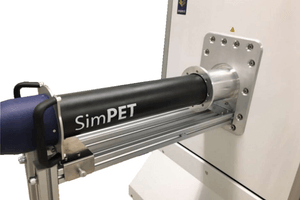Accurate diagnosis and staging are essential for the optimal management of cancer patients. Positron emission tomography (PET) and magnetic resonance imaging (MRI) in a combined PET MR scanner has emerged as a powerful imaging tool for the detection of various cancers. The combined acquisition of PET and CT has synergistic advantages over PET or CT alone and minimises their individual limitations. It has an important role in the detection of recurrence in asymptomatic patients with rising tumour marker levels and patients with negative or equivocal findings on conventional imaging techniques. It also allows for monitoring response to therapy and permitting timely modification of therapeutic regimens.
In about 27% of patients, the course of management is changed. This review provides guidance for oncologists/radiotherapists and clinical and surgical specialists on the use of the PET MR System in oncology. Combined PET MR Systems are especially beneficial in the treatment of pediatric cancer patients. They offer opportunities for more efficient, accurate and safe diagnoses of pediatric cancer patients. The impact on patient management and outcomes has to be substantiated by large-scale prospective clinical trials.
Since many primary tumours in children are evaluated with MRI and metastases are detected with PET CT, integrated PET MR can be a time-efficient and convenient solution for pediatric cancer staging. PET MR can assess primary tumours and the whole body in one imaging session, avoid repetitive anaesthesia and reduce radiation exposure.
Key Benefits in Preclinical Settings
Combined PET MR Systems have key benefits in preclinical settings, including:
- Lesser radiation dose: PET MR Systems offer lesser radiation dose from MRI as compared to other hybrid imaging technologies.
- Simultaneous multi-modality imaging: PET MR technology offers simultaneous multi-modality preclinical imaging, which is useful for functional imaging solutions.
- Excellent soft tissue contrast: PET MR technology provides excellent soft tissue contrast, which is useful for imaging small animals.
- Robust imaging evaluation: PET MRI may be preferred over PET CT where the unique features of MRI provide more robust imaging evaluation in certain clinical settings.
- Motion correction: MRI offers motion correction in reconstruction of the anatomical information, which is useful for reducing errors due to patient motion between the two acquisitions.
PET MR systems offer opportunities for more efficient, accurate and safe diagnoses of cancer patients. The impact on patient management and outcomes has to be substantiated by large-scale prospective clinical trials.
Although the two technologies were initially regarded as inherently incompatible, different solutions have been developed and implemented to realise PET MR instruments for both human and small animal bimodal imaging.
With this bimodal approach novel functional-anatomical and multiparametric applications become feasible, which can be expected to deliver information beyond that accessible by separately applied modalities.
However, PET MR technology also has some disadvantages compared to other hybrid imaging technologies, including high initial capital cost, lack of protocol and standardisation due to huge variations in MR protocols, no combined reporting of PET and MR components, limited flexibility of combined PET MR systems, and high acquisition times of up to 60 minutes.
Advantages Over Conventional Imagery
Despite these challenges, PET MR technology has become a mature technology and offers advantages over conventional imaging modalities.
- Improved Imaging: PET and MRI provide complementary information, with PET providing molecular information and MRI providing soft-tissue imaging. By combining the two, researchers can obtain more comprehensive information about the model being studied.
- Co-Registered Images: The fused data from PET and MRI allows researchers to co-register images and obtain a more complete picture of the model being studied.
- Continuous Monitoring: Combined PET MR systems can also include devices such as tissue oxygen monitors, which offer key advantages over devices based on polarographic methods. These monitors can provide continuous measurement of tissue oxygen levels, allowing researchers to better understand the effects of various interventions on tissue oxygenation.
However, even if PET MR proves valuable, it cannot enter mainstream applications if it is not accessible to the majority of cancer patients. Therefore, innovations are needed to make PET MR scanners affordable and increase patient throughput.
Overall, combined PET MR systems offer a powerful tool for researchers to obtain more comprehensive information about models being studied, as well as improved control over anaesthesia and continuous monitoring of tissue oxygen levels.
References
- https://www.news-medical.net/life-sciences/Combined-PET-MR-Principles-Strengths-and-Weaknesses.aspx
- https://www.ncbi.nlm.nih.gov/pmc/articles/PMC3800216/
- https://jnm.snmjournals.org/content/56/2/165
- https://ejhi.springeropen.com/articles/10.1186/s41824-018-0030-6
- https://journals.sagepub.com/doi/pdf/10.1177/153303461000900102
- https://link.springer.com/article/10.1007/s40336-023-00572-6
- https://scintica.com/product/imaging/m7-simpet/
- https://scintica.com/is-1-tesla-enough-how-low-field-mri-is-permitting-more-preclinical-researchers-to-utilize-this-gold-standard-technique-than-ever-before-small-animal-rat-mouse-mice/
- https://scintica.com/product/surgery/anesthesia/
- https://scintica.com/product/physiology/tissue-oxygen-monitor/
